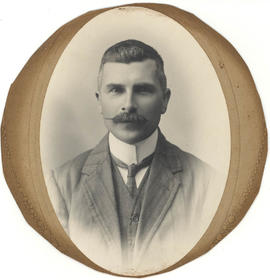- PRG
- Persoon
- 1656-1749
Showing 644 results
Geauthoriseerde beschrijving- PRI
- Persoon
- 1942-1969
The first (and only?) Indonesian palynologist, Dr Botjah Prijanto was born on the 1 April 1942 in Djombang, East Java. He studied at the College of Agricultural Sciences at Tjiawi, Bogor where he obtained his Batchelor degree in 1962 (taxonomy of flowering plants) and discovered a new species of Lancium (Meliaceae).
Prijanto then joined the Botany Division of the Forestry Research Institute in Bogor as Assistant Botanist before continuing his studies at the University of Edinburgh in 1963 under the supervision of Dr Peter H. Davies and Brian (Bill) L. Burtt. He submitted a thesis on the taxonomic problems of the Scrophulariaceae and was awarded the degree of Doctor of Philosophy in 1966.
Prijanto then spent a year in the Palynological Laboratory in Stockholm where he studied palynology under Prof. G. Erdtman.
In 1968 he was appointed Botanist at the Forest Research Institute in Bogor, regularly working in the Herbarium Bogoriense.
He travelled to many places in Indonesia on field trips, including Udjong Kulong, Sumbawa and South Sumatra. In 1969 he was collecting in South Celebes when he was tragically killed in a car accident.
(Reference, Reinwardtia, vol.8, 1970, pp.1-2)
- Q1043
- Persoon
- Q204566; GB/NNAF/P126501; VIAF ID: 64335134 (Personal); ISNI: 0000 0000 4457 4445
- Persoon
- 1873-1932
Born in Falkirk in 1873, George Forrest became one of Scotland's most prolific plant collectors, conducting seven expeditions in Yunnan province, S.W. China between 1904 and his death there in 1932.
- Q21508057; GB/NNAF/P144510
- Persoon
- 1872-1965
Born 1872; died 1965. Plant collector
George Cave trained as a Kew gardener, graduating in 1895. In 1896 he became assistant at the Botanic Gardens, Calcutta and in 1900 was appointed Governor of the Cinchona Plantations, Mungpoo (Bengal). In 1904 he became curator of the Lloyd Botanic Garden, Darjeeling. He went on numerous plant collecting tours in Tibet, Nepal and Sikkim and some diaries from these tours are held by the Royal Botanic Garden Edinburgh.
Sources: Desmond; Rowena Cave, ‘George Cave’s Diary, Sikkim 1906’.
D.W.
- Q21513491; VIAF ID: 282222228
- Persoon
- 1830-1905
Born Edinburgh 1830; died Edinburgh 1905
The son of William Fraser who was a partner in the Neill & Co. printing firm in Edinburgh, Patrick Neill Fraser took over the firm on the death of its owner, the naturalist Patrick Neill, in 1851. He established a renowned garden at his home, Rockville, in Murrayfield, Edinburgh specialising in alpine plants and both tender and hardy ferns, as well as polyanthus. He was treasurer of the Royal Caledonian Horticultural Society for 28 years and was also a member of the Royal Society of Edinburgh and Royal Scottish Geographical Society.
Sources : R. Desmond ‘Dictionary of British and Irish Botanists and Horticulturalists; obituary folder
D.W.
- Q21516783; GB/NNAF/P144093
- Persoon
- 1898-1962
- Q2268390; ISNI: 0000 0000 8224 595X; VIAF ID: 46828164 (Personal)
- Persoon
- 1855-1934
- Q2846555; GB/NNAF/P135012
- Persoon
- 1630-1694
Born Fife 1630; died Edinburgh 1694
Brought up at the family seat, Balfour Castle in Fife, Andrew Balfour studied philosophy at St Andrews University graduating MA in about 1650. He spent several years in Paris studying medicine eventually graduating MD at Caen in 1661. Returning to London and having been presented to Charles II he acquired a position as a tutor to the earl of Rochester, accompanying him on a grand tour from 1661 to 1664. During his 15 years abroad Balfour acquired an extensive library of medical and natural history books, together with collections of antiquities, pictures, arms, instruments, plants, animals and fossils. In 1667 he returned to St Andrews, practising as a physician, before moving to Edinburgh to build up a medical practice there; it is claimed that he was the first doctor in Scotland to dissect the human body. In 1670, with his distant cousin and friend Robert Sibbald, he leased land for a small garden at St Anne’s Yards, Holyroodhouse, and later petitioned the town council for a larger plot adjacent to Trinity Hospital, in which were planted 2,000 non-indigenous species. He played a prominent role in Edinburgh’s learned society and opened his private museum collections, gallery and library to scholars. He was knighted in 1682 for his contribution to science and society and was active in establishing professorial chairs and in founding the Royal College of Physicians in Edinburgh, becoming president in 1685. He improved the infirmary and arranged publication of the first ‘Edinburgh Pharmacopoeia’ (1685) to which he contributed parts on materia medica. After his sudden death in the street in 1694 most of his collections were broken up and his library sold.
Sources: DNB; Fletcher and Brown ‘The Royal Botanic Garden Edinburgh 1670-1970’; Deni Bown, ‘4 Gardens in One’; (R. Desmond ‘Dictionary of British and Irish Botanists and Horticulturalists)
D.W.
- Q2976019
- Persoon
- 1846-1922


